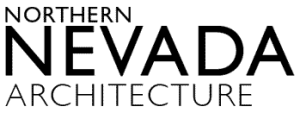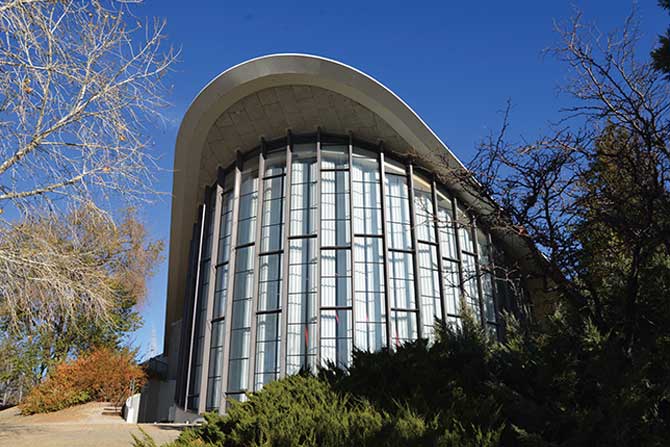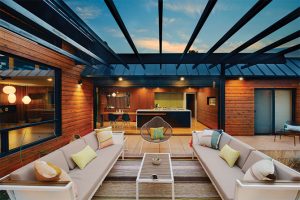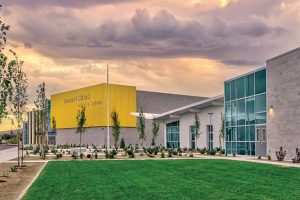By Bradley Carlson, AIA, AIANN President Elect
As the incoming AIANN President for 2021 and Chair of the City of Reno Historical Resources Commission — and being a native of Reno with my family having first arrived at Reno’s founding in 1868 — I am passionate about and inspired by our community’s history and architectural legacy. With our region’s unique identity and history, we have grown into a community that fosters and attracts creativity and innovation.
Creativity and innovation are nothing new to Northern Nevada and Reno. The geography and culture of our area have long attracted people of vision. This has created an environment that fosters a rich and unique community and architectural legacy. Our architecture’s uniqueness comes from those who are from or choose to come to our state to make it their home, bringing their collective ideas, talents and backgrounds.
INSPIRATION FROM THE PAST
The middle of the 20th century was a time of rapid change in Nevada and the nation. This was a time of reconsidering the “old rules” and inspiring a drive to move forward. The Postwar period brought the Cold War, civil unrest, and increased awareness of our impact on the environment. It was also a period of great scientific achievements, exploration, and innovation.
During this time, Nevada was also experiencing formidable growth and change. As Reno was maturing and diversifying, the architecture and design community began to explore new ideas, looking to Modern Movement influences — interpreting and adapting these through a regional and local lens. This was a seminal time for design in Reno’s built environment, with innovative and radical new architecture ideas responding to a growing and diverse community.
This was a period when Nevada architects and engineers were innovating, looking forward and reexamining how the buildings we design contribute to our community. Architects were rethinking the old ways and exploring new solutions to old problems. Northern Nevada architects were meeting this challenge — inspired, innovating, and contributing to architectural design trends and ideas happening both locally and nationally.
Northern Nevada was also attracting talented architects from outside our region. Architects such as Hewitt C. Wells and Raymond Hellmann came to Reno during this period and proceeded to innovate and move Nevada’s architectural profession forward. Renowned architects from around the country, including Richard Neutra, Paul Revere Williams, and Bozalis Dickinson & Roloff, were also leaving their mark and influencing design in our community.
We are fortunate to have many surviving milestone buildings from this period. This year two of these were recognized, being added to the City of Reno’s Register of Historic Places: the Washoe County Library (1966) and the Pioneer Theater-Auditorium (1967). These joined other important Northern Nevada buildings from this Mid-Century period on the local, state, and national registers of historic places, including the Fleischmann Atmospherium-Planetarium.
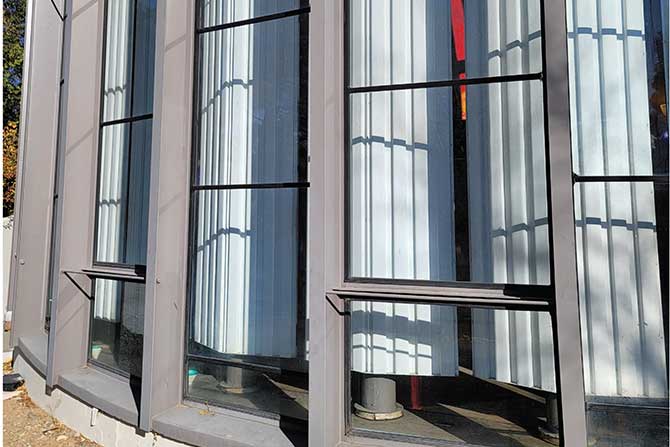
Fleischmann Atmospherium-Planetarium
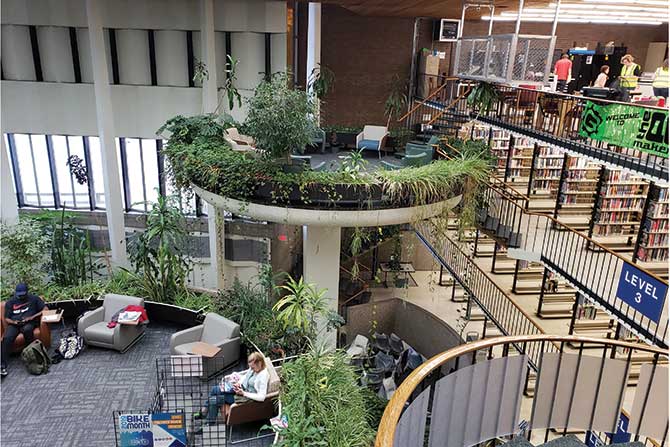
Washoe County Library

Washoe County Library
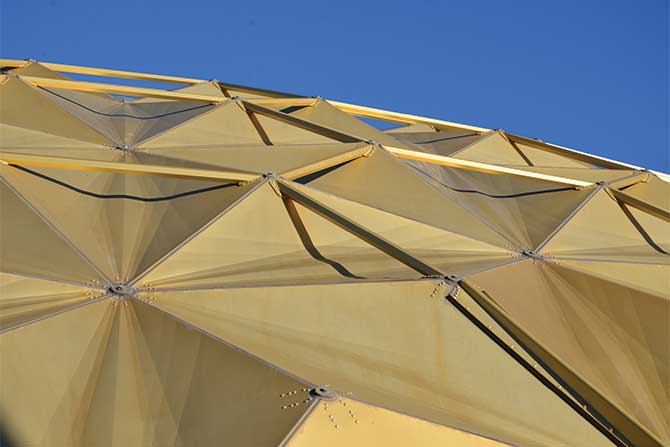
Pioneer Theater Auditorium
THREE MILESTONE AND INNOVATIVE BUILDINGS UNIQUE TO MID-CENTURY RENO
FLEISCHMANN ATMOSPHERIUM PLANETARIUM (1963)
Raymond M. Hellmann, Architect
National Register of Historic Places
(NRHP), 1994
The Fleischmann Atmospherium-Planetarium opened in 1963, under the auspices of the Desert Research Institute (DRI) — one year after JFK’s “We Choose To Go To The Moon” speech and six years before Apollo 11 achieved that goal. This was a time American communities were looking to science and research to move society forward. This building answered the call.
The Fleischmann Atmospherium-Planetarium was inspired with a focus on the future. This unique facility was the first of its kind in the world, utilizing both atmospherium and planetarium projectors to showcase, study and teach atmospheric, weather, and astronomical phenomena of both the day and night skies.
Hellmann designed this building to be as cutting-edge and inspirational as the equipment it was built for. It was innovative and forward-looking, with new construction techniques and an experimental heating and cooling system inspired by physics and nature. Its iconic poured-in-place hyperbolic-paraboloid concrete shell structure and experimental air-convection based solar heating and cooling system were radical and innovative — and happening here in Reno.
Ron James wrote, “… this was a cutting-edge expression of a society looking to a future in the Space Age and was bringing an era of invention and exploration to Nevada.”
WASHOE COUNTY LIBRARY (1966)
Hewitt C. Wells, Architect
National Register of Historic Places (NRHP), 2013
City of Reno’s Register of Historic Places, 2020
The Washoe County Library, opening in 1966, ushered in a new era in Reno’s cultural expansion. Hewitt C. Wells created a library and a centerpiece for Reno’s cultural activities, a space to nurture a growing and thriving cultural community.
Wells organized the design of this building around a roofed and enclosed internal garden atrium, with hundreds of plants and trees, a pond and a fountain. He described the concept for the building as “a park within a library.” The original plan called for the new library to be constructed in Wingfield Park, for which Wells was also involved in the design. When the proposed library’s site was changed to its location on South Center Street, an inspired Wells said, “I’ll turn it inside out [and] put the park inside.” He noted that “This is an entirely different concept for a library.” Wells credited the cooperation and support that he received for this revolutionary design, as it “… could only have been done with an imaginative client.”
The building’s brick façade opens to the street, creating a gracious grand entrance detailed with embossed copper panels and glass woven between steel columns. Upon entering the building, visitors cross a bridge through a tree canopy to the circulation desk. Architectural features include elevated circular reading areas and book stacks open to the atrium.
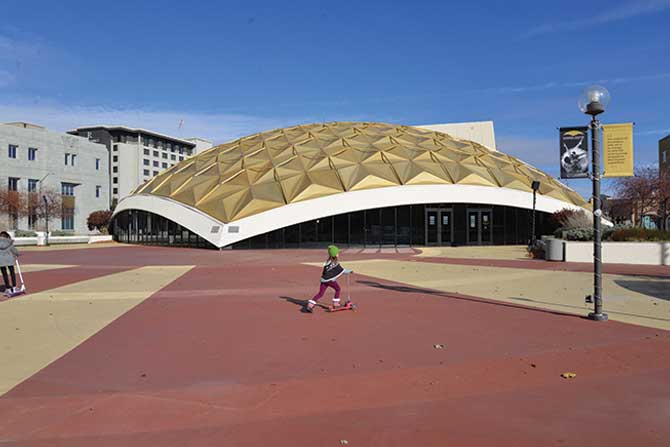
Pioneer Theater Auditorium
Wells designed this building to complement and be unified with his design for the new Reno City Hall (now the Discovery Museum), which opened the year before. The library shares many materials, detailing and features with the 1965 City Hall — including its brickwork, glass and copper details. Both buildings are also organized around enclosed atrium spaces.
This sensitive and unique design for the new library brought Reno national attention in 1968. Wells and his collaborators, landscape architect Mitchell Serven, and Purdy and Fitzpatrick Nursery received the Industrial Landscape Award from the American Association of Nurserymen. Lady Bird Johnson presented this award in Washington DC, as part of her American Cities Beautification Program.
PIONEER THEATER – AUDITORIUM (1967)
Bozalis Dickinson & Roloff, Architect / Temcor
National Register of Historic Places (NRHP), 2005
Nevada State Register of Historic Places (SHPO), 2000
City of Reno’s Register of Historic Places this year, 2020
In the 1960s, cities across the country were building facilities for the performing arts and conventions. Reno was no exception. As Reno was gearing up to be in step with the country, the Pioneer Theater-Auditorium was conceived and built to address growing community needs and established Reno as more than a “casino town.”
This was Reno’s first theater stage for major productions outside of the casinos. To help attract and support convention business to Reno, the Pioneer also incorporated meeting and exhibit spaces below the adjacent plaza. It provided a link for convention activities between downtown and the new Centennial Coliseum (now Reno-Sparks Convention Center) to the south, which opened in 1965 and was designed by Richard Neutra in collaboration with the Reno firm of Lockard, Casazza, Parsons & Associates.
The R. Buckminster Fuller-inspired geodesic dome of this building was provocative in Reno from the beginning, designed and built by Temcor, whose co-founder Don Richter was a student of Fuller. With this iconic dome hugging the adjacent plaza and framing the theater lobby entrances, the building’s massing celebrates the dome and its unique structure, bringing it right down to the pedestrian level.
INFORMING OUR FUTURE:
Today, as we usher in the third decade of the 21st century, our communities are again confronted with social and environmental challenges, similar to those of the prior Mid-Century period. Many of the forces shaping the Postwar era and the 1960s are still with us today and evolving. Monumental challenges affecting our communities and our profession are compounded by the pandemic, monumental commerce and population shifts, civil unrest, inequities in social inclusion and global climate change. All this has come center stage in 2020, challenging architects and designers to guide and lead our communities. As innovators and creatives, architects have the skills to turn these challenges into opportunities. Many of the “old rules” are now suspended in addressing these issues, and no new ideas are off the table.
What can we learn and be inspired by from the work of past generations of our community’s leading architects? Local architects like Ray Hellmann and Hewitt Wells were innovating and collaborating with project teams to meet the requirements of their clients and responsibly meet the challenges of the community and societal issues of their time. They have left us with a significant legacy of architectural contributions, attesting to their skills, talent and innovative solutions.
Architects are uniquely experienced and skilled in creating and developing the visions that shape, guide and move our communities forward. Our profession is now presented with big challenges, offering opportunities to meet our community’s needs — an invitation to rise to the occasion with new design innovations. This creates a great opportunity for our profession in the community and a responsibility to guide and inspire the next generation of architects and designers.
